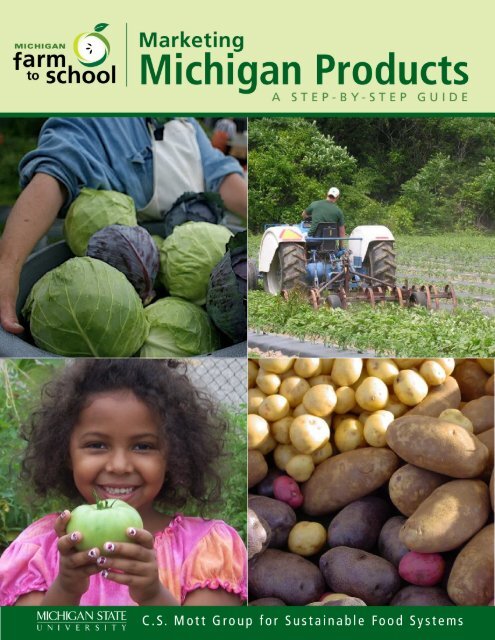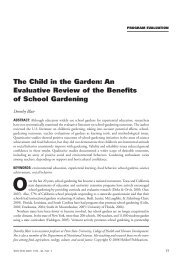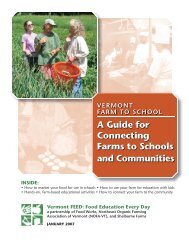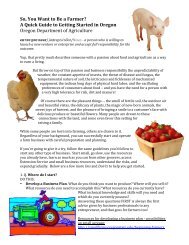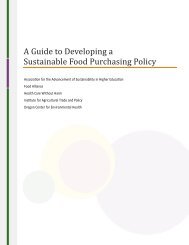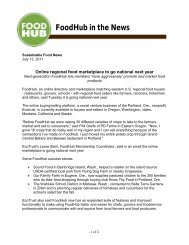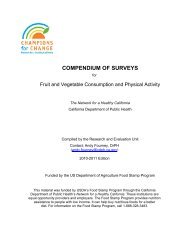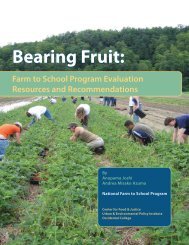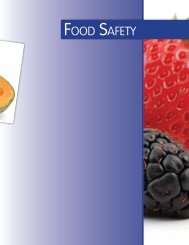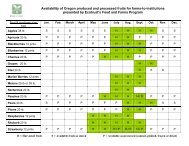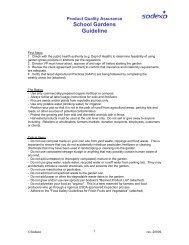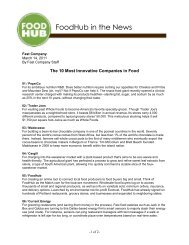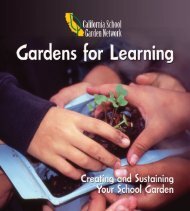Marketing Michigan Products to Schools: A Step-By-Step Guide
Marketing Michigan Products to Schools: A Step-By-Step Guide
Marketing Michigan Products to Schools: A Step-By-Step Guide
- No tags were found...
You also want an ePaper? Increase the reach of your titles
YUMPU automatically turns print PDFs into web optimized ePapers that Google loves.
<strong>Michigan</strong> State University • C.S. Mott Group for Sustainable Food Systems • www.mifarm<strong>to</strong>school.msu.edu2 of 47
• Prepare product availability and pricing forms <strong>to</strong> help market your products andrespond <strong>to</strong> requests for quotes or bids from schools. Include seasonal availabilityand pricing for all varieties, sizes, and packs of products you grow and market.Tool: Pricing for school meals programsTool: Completing product availability and pricing formsTool: Sample product availability and pricing sheetTool: Sample vendor questionnaire• Gather and include copies of documents pertaining <strong>to</strong> inspections, certifications,insurance, and/or food safety in your bid packet. If you can, provide contactinformation of other cus<strong>to</strong>mers who would be willing <strong>to</strong> offer positive references.• Understand how your bid will be evaluated when you respond <strong>to</strong> schools’requests for quotes or bids. Review typical criteria for evaluating and selectingbids, and describe how your products stack up. Determine which value-addedservices you can offer, like participating in school visits or school fundraisers, andinclude those services in the marketing materials and bids you submit <strong>to</strong> schools.Tool: Sample evaluation criteria for selecting vendors• Submit your bid <strong>to</strong> prospective cus<strong>to</strong>mers.<strong>Step</strong> 4: Develop Contract or Agreement with <strong>Schools</strong>• Invite new cus<strong>to</strong>mers <strong>to</strong> <strong>to</strong>ur your farm/business before you begin sellingproducts <strong>to</strong> them, and ask for a <strong>to</strong>ur of the schools’ food service facilities.• Meet face-<strong>to</strong>-face with school food service direc<strong>to</strong>rs <strong>to</strong> determine your mutualneeds prior <strong>to</strong> establishing an agreement or contract. Be sure <strong>to</strong> discuss anordering schedule, delivery and packaging requirements, and payment terms.Co-write agreements or contracts with your new school cus<strong>to</strong>mers. Be sure <strong>to</strong>discuss the best methods for maintaining contact (phone, email, or fax) andsharing news about new products or services. You can use a sample invoice inAppendix III as a template for invoicing school cus<strong>to</strong>mers.<strong>Michigan</strong> State University • C.S. Mott Group for Sustainable Food Systems • www.mifarm<strong>to</strong>school.msu.edu6 of 47
<strong>Step</strong> 5: Begin Selling Your <strong>Products</strong> <strong>to</strong> Local <strong>Schools</strong>• Stay in regular <strong>to</strong>uch with school cus<strong>to</strong>mers <strong>to</strong> ensure cus<strong>to</strong>mer satisfaction,maintain a good professional relationship, and notify them of new products orservices.• Be proactive, and keep the value-added services coming! Offer <strong>to</strong> visit schoolclassrooms and cafeterias <strong>to</strong> do educational programs and/or taste tests withstudents. Offer <strong>to</strong> host school field trips at your farm. Suggest products that maybe particularly suitable <strong>to</strong> school fundraisers. Develop clear plans for any of theseopportunities before discussing them with school cus<strong>to</strong>mers.AppendicesI: “Buying Local – Approved Food Sources for Food Establishments” from<strong>Michigan</strong> Department of AgriculturalII: School Food Programs and RegulationsIII: Sample Invoice<strong>Michigan</strong> State University • C.S. Mott Group for Sustainable Food Systems • www.mifarm<strong>to</strong>school.msu.edu7 of 47
markets such as colleges/universities, hospitals, and/or correctional facilities. Thechallenges and constraints that institutional food service programs face are oftensimilar, but there are no one size fits all solutions or strategies for farm <strong>to</strong> institutionprograms. Programs vary depending upon the location, agricultural production andseasonal availability in the area, and the type, size, equipment, and delivery needs of afood service program. While the guide cannot give you all of the answers, it is designed<strong>to</strong> prepare you <strong>to</strong> access school markets and provides questions <strong>to</strong> ask and getanswered as you embark on this new marketing venture.<strong>Michigan</strong> State University • C.S. Mott Group for Sustainable Food Systems • www.mifarm<strong>to</strong>school.msu.edu9 of 47
<strong>Step</strong> 1: Get Started - Farmer Self-AssessmentThe following questions are designed <strong>to</strong> help you determine your interest and ability <strong>to</strong>market your food products <strong>to</strong> local schools. This information is not necessarily forsharing with schools but is essential for you <strong>to</strong> know and will be helpful when you begintalking with school food service direc<strong>to</strong>rs and/or distribu<strong>to</strong>rs about supplying food <strong>to</strong>local schools and/or school districts.1. Farm Business and DescriptionHave your contact and basic farm information available in writing when you beginconversations with school food service direc<strong>to</strong>rs, including:a. Your name and farm/business name, address, phone number, fax number,email address, and website, if applicable; a business card with thisinformation is helpfulb. What are your months of operation for production, and for marketing?c. What days and hours is your farm business open?d. What days and hours are you available?Farm Descriptione. What size is your farm? How many acres are in production? Would you bewilling <strong>to</strong> expand production <strong>to</strong> additional acreage? Would you be willing orable <strong>to</strong> adjust your crop mix on your current acreage?f. What are your full costs of production per acre, and per crop, including alllabor? What is the minimum amount in profit per crop you need <strong>to</strong> continue <strong>to</strong>grow that crop?g. Farm <strong>Products</strong> and Productioni. School food service direc<strong>to</strong>rs are often most interested in fruits andvegetables for school meals programs, but some schools are alsointerested in purchasing specialty products for special events. Otherfarm products like apples, flowers, honey, maple syrup or pumpkinsare good for school fundraisers. What types of products do yougrow/raise?□ Fruits□ Vegetables□ Meats□ Dairy□ Eggs<strong>Michigan</strong> State University • C.S. Mott Group for Sustainable Food Systems • www.mifarm<strong>to</strong>school.msu.edu10 of 47
□ Specialty <strong>Products</strong>□ Herbs□ Plants, trees□ Flowers□ Fiber <strong>Products</strong>ii.If you grow fruits and/or vegetables, please note which ones in thechart below. Which products might you be willing and able <strong>to</strong> grow andsell, if schools express interest? Remember, flexibility is key.Vegetable Currently Grow and Sell Willing <strong>to</strong> Grow and SellAsparagus Beets Broccoli Brussel Sprouts Cabbage Carrots Cauliflower Celery Corn Cucumbers Green Beans Greens (collards, kale, etc.) Eggplant Lettuce (Romaine, Bibb, etc.) Onions Parsnips Peas Peppers Pota<strong>to</strong>es Pumpkins Radishes Salad Greens Spinach Squash, summer(yellow, zucchini) Squash, winter(butternut, acorn, etc.) <strong>Michigan</strong> State University • C.S. Mott Group for Sustainable Food Systems • www.mifarm<strong>to</strong>school.msu.edu11 of 47
Toma<strong>to</strong>es (cherry, slicing, etc.) Turnips Other:Other:Fruit Currently Grow and Sell Willing <strong>to</strong> Grow and SellApples Blueberries Cantaloupe Cherries Grapes Muskmelon Pears Plums Raspberries Rhubarb Strawberries Watermelon h. Production practices (Please check all that apply):i. Certified/verified practices□ Certified organic□ Certified naturally-grown□ Good Agricultural Practices (GAP) certified□ MAEAP (<strong>Michigan</strong> Agriculture Environmental AssuranceProgram) verifiedii.Other practices□ Organic□ GMO-free□ Integrated pest management□ Pesticide free□ Synthetic chemical free<strong>Michigan</strong> State University • C.S. Mott Group for Sustainable Food Systems • www.mifarm<strong>to</strong>school.msu.edu12 of 47
□ Hormone free□ Pasture-raised□ Grass-fed□ Free-range□ Hydroponic□ Other __________________________________________i. Pest managementi. Please describe your pest management practices, including integratedpest management.ii.Are you willing <strong>to</strong> inform school cus<strong>to</strong>mers of pesticide applications, ifapplicable?j. List annual inspections and certifications your farm/business receives fromUSDA, state, or local inspec<strong>to</strong>rs and/or third-party audi<strong>to</strong>rs or certifiers, andtheir frequency (annual, bi-annual, etc.). Gather your latest inspection reports,certification documentation, farm plan and/or food safety and sanitation plan.Are you willing <strong>to</strong> share these inspection and/or certification reports withschool cus<strong>to</strong>mers?k. Do you have a HACCP (Hazard Analysis and Critical Control Points) plan? Ifso, please describe.l. Do you have an insurance policy that has product liability coverage? What isthe payment limit? If you are willing <strong>to</strong> host school field trips, does yourinsurance offer liability coverage for your property/premises, often known asgeneral liability?m. Do you have greenhouses and/or hoop houses on your farm for extendedseason production? How does this affect your product availability?n. Do you have post-harvest s<strong>to</strong>rage facilities on your farm? If so, for whatproducts? Please describe.o. Are you able <strong>to</strong> wash and/or pack farm products? If so, note which productscan be washed and packed, and describe if applicable. (Please note thatadditional certifications are required for processing farm products.)2. Salesa. Are you primarily a wholesaler or retailer? To which types of markets do youcurrently sell farm products?<strong>Michigan</strong> State University • C.S. Mott Group for Sustainable Food Systems • www.mifarm<strong>to</strong>school.msu.edu13 of 47
k. What are your requirements for payment? Within 15, 30 or 60 days?4. <strong>Marketing</strong> and Servicea. What is your policy for products of poor quality? Are you willing <strong>to</strong> offer creditsor returns? Be clear about your policy with school cus<strong>to</strong>mers, and rememberthat good cus<strong>to</strong>mer service goes a long way in building good relationshipswith cus<strong>to</strong>mers.b. Are you willing <strong>to</strong> provide taste tests for potential school cus<strong>to</strong>mers?c. Are you willing <strong>to</strong> sell products for school fundraisers? Or would you beinterested in developing a special line of products for farm <strong>to</strong> schoolfundraisers?d. Are you willing <strong>to</strong> have school cus<strong>to</strong>mers visit and <strong>to</strong>ur your farm/business?e. Is your farm available for student field trips? If so, please describe a plan orprogram for field trips.f. Are you available <strong>to</strong> visit school cafeterias and/or classrooms and talk withstudents about your farm products and how they are grown?<strong>Michigan</strong> State University • C.S. Mott Group for Sustainable Food Systems • www.mifarm<strong>to</strong>school.msu.edu15 of 47
<strong>Step</strong> 1: Get Started - Addressing Food SafetyAccording <strong>to</strong> the <strong>Michigan</strong> Department of Agriculture, food establishments, includingschools, can obtain raw, uncut produce directly from growers. 3 To sell <strong>to</strong> schools (andother institutional food establishments like hospitals and colleges) farmers must becomean “approved source” or vendor for that school. This simply means that schools mustaccept/approve their vendors, and then add them <strong>to</strong> their invoicing and paymentsystems. Although farmers are not typically licensed by the <strong>Michigan</strong> Department ofAgriculture, “all producers are responsible <strong>to</strong> assure that their produce is safe andwholesome and must comply with applicable laws.” 4Good Agricultural Practices (GAP) AuditsOne way <strong>to</strong> help ensure food safety and sanitation on your farm and/or in your handlingfacility is <strong>to</strong> conduct a GAP (Good Agricultural Practices) and/or GHP (Good HandlingPractices) audit through the USDA with state audi<strong>to</strong>rs. Developed in 2001, GAP/GHP isa voluntary audit program that attempts <strong>to</strong> verify growers’ efforts <strong>to</strong> minimize food safetyand microbial hazards in fresh fruits and vegetables. In other words, growers candetermine how their on-farm food safety and sanitation practices compare <strong>to</strong> nationalstandards. More buyers are asking suppliers <strong>to</strong> have GAP or other food safety auditsdue <strong>to</strong> growing food safety concerns, but GAP is only required when selling products <strong>to</strong>USDA Commodity Procurement. Farm audits are on a per crop basis and occur atharvest time. Fees are required for the time and services of the audi<strong>to</strong>r. Before callingan audi<strong>to</strong>r <strong>to</strong> conduct a GAP audit on your farm, you can conduct a self-audit <strong>to</strong> be sureyou are prepared for an audi<strong>to</strong>r and will be likely <strong>to</strong> pass the audit. You can access the“USDA GAP/GHRP Audit Verification Checklist” athttp://www.ams.usda.gov/AMSv1.0/getfile?dDocName=STELPRDC5050869 and “GoodAgricultural Practices: A Self-Audit for Growers and Handlers” from the University ofCalifornia-Davis at http://ucce.ucdavis.edu/files/filelibrary/5453/4362.pdf.Aside from manda<strong>to</strong>ry general questions, growers can request which sections of theGAP audit they would like <strong>to</strong> pursue for certification, and do not have pursue all. GAP isdivided in<strong>to</strong> 5 sections known as “scopes” that cover the journey of food from farm <strong>to</strong>fork, with an optional food defense scope:1. Farm Review: water, sewage, manure, animals and wildlife, soils and landuse2. Field Harvest and Field Packing: worker sanitation and hygiene, and fieldharvesting and transportation3 <strong>Michigan</strong> Department of Agriculture. Buying Local – Approved Food Sources for Food Establishments. AccessedNovember 2009 at http://www.mi.gov/mda/0,1607,7-125-50772_51200_51231-213569--,00.html.4Ibid.<strong>Michigan</strong> State University • C.S. Mott Group for Sustainable Food Systems • www.mifarm<strong>to</strong>school.msu.edu16 of 47
3. House Packing Facility: receiving, washing/packing line, worker health andhygiene, general housekeeping and pest control4. S<strong>to</strong>rage and Transportation: s<strong>to</strong>rage areas, containers and pallets, pestcontrol, ice and refrigeration, transportation/loading, worker health andpersonal hygiene5. (Not Used)6. Wholesale Distribution Center/Terminal Warehouses: receiving, s<strong>to</strong>ragefacility/temperature control, pest control, repacking/reconditioning, workerhealth and personal hygiene, shipping/transportation7. Preventive Food Defense Procedures: secure employee/visi<strong>to</strong>r procedures,secure facility procedures 5GAP audits require growers <strong>to</strong> develop food safety plans and keep good records of theirfarm production and harvesting practices of fruit and vegetable crops. To identify foodsafety risks, develop solutions, and cover the GAP scopes, these plans should includethe following <strong>to</strong>pics, as applicable:• Record-keeping• Worker hygiene and training• Toilets and handwashing facilities• Water use include irrigation and spray water quality and on-farm wells• Pesticide use and s<strong>to</strong>rage• Manure sources, use and application practices, on-farm s<strong>to</strong>rage and handling• Compost sources, on-farm s<strong>to</strong>rage, and application practices• Wild animal management• Harvest and field sanitation• Postharvest handling and packing house sanitation and safety• Farm biosecurity including building security, visi<strong>to</strong>r pro<strong>to</strong>cols, and employeehiring• Crisis management 6Implementation of a food safety program and designated person(s) <strong>to</strong> overseeimplementation of that program are prerequisites for a GAP/GHP audit. A minimumscore of 80% is required <strong>to</strong> “pass” the audit. There are five au<strong>to</strong>matic “unsatisfac<strong>to</strong>ry”components which will disqualify a grower from passing. These include:5USDA. (2009) USDA Good Agricultural Practices and Good Agricultural Practices Audit Verification Checklist.Accessed January 2010 at http://www.ams.usda.gov/AMSv1.0/getfile?dDocName=STELPRDC5050869.6 Rangarajan, A. et al. Food Safety Begins on the Farm: A Grower Self Assessment of Food Safety Risks. Ithaca, NY:Cornell University, 2003. Accessed January 2010 athttp://www.gaps.cornell.edu/Educationalmaterials/FApdfs/CompleteAssessment.pdf.<strong>Michigan</strong> State University • C.S. Mott Group for Sustainable Food Systems • www.mifarm<strong>to</strong>school.msu.edu17 of 47
• Immediate food safety risk is present when produce is grown, processed,packed, or held under conditions that promote or cause the product <strong>to</strong> becomecontaminated• Presence or evidence of rodents, excessive amount of insects or other pests inthe production area during packing, processing, or s<strong>to</strong>rage• Observation of personal or hygienic employee practices that jeopardize or mayjeopardize the safety of the produce• Falsification of records• Answering general Questions 1 or 2 “no”:ooIs there a documented food safety program that incorporates GAP?Has a person on the farm has been designated <strong>to</strong> implement and overseean established food safety program?Other Third-Party AuditsWhile some buyers require their suppliers <strong>to</strong> have GAP/GHP audits, others arerequesting third-party audits from independent audi<strong>to</strong>rs. Among others, SQF 1000(http://www.sqfi.com/suppliers.htm), NSF Davis Fresh(http://www.nsf.org/business/nsf_davis_fresh/audits.asp?program=DavisFre) andPrimus Labs (www.primuslabs.com) are third-party audi<strong>to</strong>rs that offer field and facilitiesaudits. Primus Labs also gives users an option <strong>to</strong> conduct a self-audit <strong>to</strong> determineareas in need of improvement, which is especially helpful if you are planning <strong>to</strong> requesta third-party audit of your farm operations. This no cost self-audit is a good <strong>to</strong>ol <strong>to</strong>document and describe your food safety practices for new or potential cus<strong>to</strong>mers.On-Farm Food Safety and SanitationIowa State University Extension and the Leopold Center for Sustainable Agriculturedeveloped some questions for food buyers <strong>to</strong> ask prospective vendors in order <strong>to</strong> learnmore about food safety practices. Even before you request an on-farm food safety audit,you can assure potential cus<strong>to</strong>mers of food safety with positive answers <strong>to</strong> the followingquestions, descriptions of practices, thorough records and regular moni<strong>to</strong>ring. Inviteschool food service professionals <strong>to</strong> visit your farm so you can describe and they cansee in person your production practices.Farm and Production Practices1. Is water tested annually?2. Are test records on file?3. Are wells protected from contamination?4. If raw manure is incorporated in<strong>to</strong> the soil, is it added at least two weeks prior <strong>to</strong>planting or 120 days prior <strong>to</strong> harvest?<strong>Michigan</strong> State University • C.S. Mott Group for Sustainable Food Systems • www.mifarm<strong>to</strong>school.msu.edu18 of 47
5. Are baskets, <strong>to</strong>tes, or other containers used <strong>to</strong> collect or transport food productscleaned or sanitized before each use? What is used <strong>to</strong> clean containers?6. Are packing materials used for food products clean?7. Are packing containers appropriate for food contact?8. Are food products kept at appropriate temperatures?9. Is the source of wash water used on food products and s<strong>to</strong>rage containersprotected from cross contamination (e.g. manure, lives<strong>to</strong>ck, pets)?10.Are food products washed, rinsed and sanitized?11.Are food product contact surfaces washed, rinsed, and sanitized at the end ofeach day?12.Is there a pest control program in place?13.Is the food product packing facility enclosed?Worker Sanitation and Safety1. Have workers received training about proper sanitation and hygiene practices?2. Are handwashing facilities available <strong>to</strong> workers?3. Do workers wash hands at appropriate times – after eating, smoking and usingthe restroom?4. Are workers excluded from handling food products if they are ill?5. Do workers put on clean aprons or other clothes prior <strong>to</strong> washing and packingproducts?6. Are different gloves worn for harvesting and packing? 7Additional information and materials:• USDA Agricultural <strong>Marketing</strong> Service (AMS) Fresh Produce Audit VerificationPrograms - http://www.ams.usda.gov/AMSv1.0/gapghp• “<strong>Guide</strong> <strong>to</strong> Minimize Microbial Food Safety Hazards for Fresh Fruits andVegetables” – freely available athttp://www.fda.gov/food/guidancecomplianceregula<strong>to</strong>ryinformation/guidancedocuments/produceandplanproducts/ucm064458.htm• Cornell University’s National GAPs website atwww.gaps.cornell.edu/weblinks.html offers a comprehensive list of resources andmaterials about food safetyo “Food Safety Begins on the Farm: A Grower’s <strong>Guide</strong>”http://www.gaps.cornell.edu/Educationalmaterials/Samples/FSBFEngMED.pdf• The University of California at Davis offers the following resources:7 Iowa State University and Leopold Center for Sustainable Agriculture. (2003) “A Checklist for Purchasing LocalProduce.” Accessed January 2010 at http://www.extension.iastate.edu/NR/rdonlyres/B0D64A49-9FA9-410E-849A-31865EFECE91/65301/AChecklistforPurchasingLocalProduce.pdf.<strong>Michigan</strong> State University • C.S. Mott Group for Sustainable Food Systems • www.mifarm<strong>to</strong>school.msu.edu19 of 47
o Good Agricultural Practices: A Self-Audit for Growers and Handlershttp://ucce.ucdavis.edu/files/filelibrary/5453/4362.pdfo Postharvest Technology Research and Information Centerhttp://postharvest.ucdavis.edu• Washing<strong>to</strong>n State Department of Agriculture USDA Good Agricultural and GoodHandling Practices available athttp://agr.wa.gov/Inspection/FVinspection/docs/GHP_GAP_Presentation.pdf• Sample Farm Safety Manual from the Oregon Department of Agricultureavailable athttp://www.oregon.gov/ODA/ADMD/docs/pdf/gap_safety_program.pdfFor food safety information for meat, poultry, and egg products:• Visit the USDA Food Safety and Inspection Service (FSIS) website athttp://www.fsis.usda.gov/about_fsis/index.asp<strong>Michigan</strong> State University • C.S. Mott Group for Sustainable Food Systems • www.mifarm<strong>to</strong>school.msu.edu20 of 47
<strong>Step</strong> 1: Get Started - Insurance ConsiderationsMost schools require product liability insurance of their food vendors, typically $1-2million coverage. Talk with the school food service direc<strong>to</strong>r <strong>to</strong> determine a school ordistrict’s insurance needs. Below is a short list of the types of insurance you may want<strong>to</strong> consider. 8 Coverage and details vary by insurance company so always talk with yourinsurance agent and/or at<strong>to</strong>rney when you are about <strong>to</strong> begin a new marketing venture<strong>to</strong> be sure you are protected!Product Liability Insurance may cover:• Injuries/illnesses derived from your farm productsFarm Policy may cover:• Home and personal property• Personal liability including:o complete operations and serviceso product liabilityo personal injuryo advertising injury (causing financial harm <strong>to</strong> someone else)o au<strong>to</strong> liability (trucking/delivery)• Farm personal property• Barns and other buildings*Homeowners policies exclude commercial and farm activity once you start sellingyour products. Some insurance companies offer policies that combine homeownersand farm policies in<strong>to</strong> one.Premises Liability Insurance may cover:• Injuries or damage that may occur on your property; this is especially importantfor on-farm school field trips*May overlap with farm policy or homeowners insuranceCommercial Insurance may cover:• Retail operations including inven<strong>to</strong>ry coverageWorker’s Compensation Insurance may cover:• Job-related accidents and injuries for farm workers and other employees8 Luedeman, Robert and Neil D. Hamil<strong>to</strong>n. (2003) “Selling <strong>to</strong> Institutions: An Iowa Farmer’s <strong>Guide</strong>.” Drake UniversityAgricultural Law Center. Accessed Oc<strong>to</strong>ber 2009 at http://www.law.drake.edu/centers/agLaw/docs/selling.pdf.<strong>Michigan</strong> State University • C.S. Mott Group for Sustainable Food Systems • www.mifarm<strong>to</strong>school.msu.edu21 of 47
Other• Crop insurance for compensation for crop failures or environmentally-relateddamage <strong>to</strong> crops• Mo<strong>to</strong>r vehicle insurance for farm trucks and other vehicles• U-pick operations may require special coverage or “endorsements”<strong>Michigan</strong> State University • C.S. Mott Group for Sustainable Food Systems • www.mifarm<strong>to</strong>school.msu.edu22 of 47
<strong>Step</strong> 1: Get Started - School Food BudgetsBefore embarking upon a farm <strong>to</strong> school or local food purchasing program, it isimportant <strong>to</strong> understand the conditions under which most school food service programsoperate. Below is a brief explanation of common procurement methods, fundingsources, and typical costs for the National School Lunch Program (NSLP).ProcurementIf <strong>Michigan</strong> schools participate in the NSLP, they must join a consortium <strong>to</strong> receiveUSDA foods and contract for their processing. They may also participate in aconsortium <strong>to</strong> procure commercial (non-commodity) foods if they choose. The threeconsortia in <strong>Michigan</strong> are the Great Lakes Consortium (GLC), School Purchasing andResource Consortium (SPARC), and Macomb Oakland Wayne RESA (MOR).(Membership <strong>to</strong> MOR is limited <strong>to</strong> specific counties in southeast <strong>Michigan</strong>.)In order <strong>to</strong> maintain free and open competition, competitive bidding for best price and/orother criteria is required for all products a school purchases. <strong>Schools</strong> typically contract<strong>to</strong> purchase food from an average of four vendors, including:• One or two prime vendors known as broadline distribu<strong>to</strong>rs (e.g. Sysco, GordonFood Service, VanEerden Food Service, etc.), which carry everything fromapples <strong>to</strong> napkins. <strong>Schools</strong> typically purchase 80-95% of their food from a primevendor <strong>to</strong> take advantage of early payments discounts and high volume rebates.Prime vendors typically require minimum orders of $250 - $500 and deliver a fewtimes per week.• Specialty vendors for produce, milk, and breadFederal FundingSchool food service programs that participate in the NSLP are primarily funded througha three-tiered federal meal reimbursement system, and commodity entitlement.Additional federal reimbursement is offered through other federal food programs suchas the Special Milk Program and School Breakfast Program.Children are eligible <strong>to</strong> receive free and reduced-price lunches based on their family’sincome level, based on a family of four 9 :• Paid meals: >185% of the poverty level ( > $40,793)• Reduced-price meals:130-185% of the poverty level ($28,665-$40,793)• Free meal:
National School Lunch Program (Contiguous States)July 1, 2009 – June 30, 2010 10Less than 60 % 60% or more Commodity entitlementPaid $0.25 $0.27Reduced-price $2.28 $2.30$0.1950Free $2.68 $2.70<strong>Schools</strong> receive federal reimbursement for each paid, reduced-price, and free lunchserved in the NSLP. The rate of reimbursement is one of two levels based on the <strong>to</strong>talpercentage of lunches (< 60% or > 60%) served two years prior that were free or at areduced-price. <strong>Schools</strong> are eligible <strong>to</strong> receive an additional $.02 for each lunch served if60% or more of the <strong>to</strong>tal lunches served district-wide in the second preceding year werefree or reduced-price.In addition <strong>to</strong> federal reimbursement, school food service programs are entitled everyyear <strong>to</strong> receive USDA foods at a value based on a flat rate per lunch meal served($.1950 for 2009-2010). With nearly 180 different products, USDA foods comprise about20% of the food served in school lunches. Nearly half of USDA foods are processedprior <strong>to</strong> delivery <strong>to</strong> schools. 11 Additional surplus agricultural products are offered <strong>to</strong>schools as “bonus” or free USDA foods as they become available.Other Funding:• Paid meals – cash payment for meals by students who are not eligible for free orreduced-price meals• Competitive foods – all foods for sale that are not part of a reimbursable meal,sold a la carte in the cafeteria or in school s<strong>to</strong>res or vending machines• Staff meals – cash payment for meals by school staff• Catering, if applicable• Grants, like the USDA Fresh Fruit & Vegetable Program, if applicableCostsOften separate from school or district budgets, school food service programs areexpected <strong>to</strong> be self-sufficient. Food service direc<strong>to</strong>rs must maintain budgets that at leastbreak even without any assistance from the school’s or district’s annual budget. If a foodservice program turns a profit, that revenue must be put back in<strong>to</strong> the food serviceprogram. In addition <strong>to</strong> purchasing food and supplies, school food service is oftenexpected <strong>to</strong> pay for the following:• Labor and benefits10 These reimbursement rates change every year. Check www.mifarm<strong>to</strong>school.msu.edu for updated information.11 California Food Policy Advocates and Samuels & Associates. The Federal Child Nutrition Commodity Program: AReport on Nutritional Quality. September 2008.<strong>Michigan</strong> State University • C.S. Mott Group for Sustainable Food Systems • www.mifarm<strong>to</strong>school.msu.edu24 of 47
• Utilities• Trash removal• Equipment• Capital improvementsIn 2008, the School Nutrition Association reported that the average of all costs <strong>to</strong>provide a school lunch was about $3.00, but schools were only expected <strong>to</strong> charge$2.00 per “paid” lunch. 12 As federal reimbursements for any meal category (free,reduced-price, or paid) do not make up this difference, school food service must raiseprices and/or seek additional funds through competitive foods or other services <strong>to</strong> avoidosing money on meals served <strong>to</strong> participating children.12 School Nutrition Association. “Fact Sheet: Why are School Lunch Prices Going Up?” 2008. Accessed Oc<strong>to</strong>ber 2010athttp://www.schoolnutrition.org/uploadedFiles/School_Nutrition/102_ResourceCenter/RunningYourProgram/FinancialManagement/FactSheet(3).doc.<strong>Michigan</strong> State University • C.S. Mott Group for Sustainable Food Systems • www.mifarm<strong>to</strong>school.msu.edu25 of 47
<strong>Step</strong> 2: Build Community Connections - <strong>Michigan</strong> Distribu<strong>to</strong>rsWhile many school food service direc<strong>to</strong>rs prefer <strong>to</strong> have a direct relationship withfarmers who can provide them with locally-grown products, others appreciate the easeand familiarity of sourcing local products through distribu<strong>to</strong>rs. Due <strong>to</strong> great demand forlocal products from schools and other markets in <strong>Michigan</strong>, many distribu<strong>to</strong>rs are trying<strong>to</strong> make more local products available <strong>to</strong> their cus<strong>to</strong>mers. If you are interested inreaching a wider school audience with your products, here is a short list of distribu<strong>to</strong>rs in<strong>Michigan</strong> that supply products <strong>to</strong> schools, including locally-based distribu<strong>to</strong>rs andnational broadline distribu<strong>to</strong>rs, which sell everything from apples <strong>to</strong> utensils. 13Local Distribu<strong>to</strong>rsCoastal ProduceDetroit, MIwww.coastalproduce.net313-849-3304Cherry Capital FoodsTraverse City, MIhttp://cherrycapitalfoodsllc.blogspot.com/866-943-5010; 231-943-5010Heeren Brothers ProduceGrand Rapids, MIwww.heerenbros.com616-452-8641Locavore Food Distribu<strong>to</strong>rsDetroit, MIwww.locavorefooddistribu<strong>to</strong>rs.com313-831-4100Broadline Distribu<strong>to</strong>rsSysco Food ServiceGrand Rapids, MI – 616-949-3700Detroit, MI – 734-397-7990www.sysco.comGordon Food ServiceGrand Rapids, MI888-437-3663www.gfs.comVan Eerden Foodservice CompanyGrand Rapids, MI800-833-7374www.vaneerden.comReinhart FoodServiceWarren, MI888-637-0010www.reinhartfoodservice.comMI FoodsHart, MIhttp://mifoods.net/231-629-277813Please note that this list is not exhaustive, and inclusion of a distribu<strong>to</strong>r on this list does not constitute arecommendation.<strong>Michigan</strong> State University • C.S. Mott Group for Sustainable Food Systems • www.mifarm<strong>to</strong>school.msu.edu26 of 47
<strong>Step</strong> 2: Build Community Connections - Resources <strong>to</strong> Link with <strong>Schools</strong>and Farm <strong>to</strong> School ProgramsThe heart of farm <strong>to</strong> school is the development of long-lasting relationships betweenschools and local farms. The following local resources can help farmers connect withschools that are interested in or already have farm <strong>to</strong> school programs. Be proactiveand reach out <strong>to</strong> schools before they come <strong>to</strong> you!Statewide Resources<strong>Michigan</strong> Farm <strong>to</strong> Schoolwww.mifarm<strong>to</strong>school.msu.edu<strong>Michigan</strong> Department of Educationwww.michigan.gov/mde<strong>Michigan</strong> Education Direc<strong>to</strong>ry, <strong>Michigan</strong> Start Pageswww.michiganstartpages.com/michigan/educationSearch for <strong>Michigan</strong> K-12 schools and school districts in your area.<strong>Michigan</strong> Department of Agriculturewww.michigan.gov/mda<strong>Michigan</strong> State University Extensionwww.msue.msu.edu/portal/Search for offices and educa<strong>to</strong>rs in your county or region.<strong>Michigan</strong> MarketMakerhttp://mi.marketmaker.uiuc.edu/An interactive mapping system that connects buyers and sellers of <strong>Michigan</strong> productsRegional Resources<strong>Michigan</strong> Land Use Institute, Taste the Local Difference – Northwest <strong>Michigan</strong>http://www.localdifference.org/farm<strong>to</strong>school/Food System Economic Partnership – Southeast <strong>Michigan</strong>http://fsepmichigan.org/food_service_preparation/index_htmlHealthy School Meals Farm <strong>to</strong> School Project – Muskegon Areahttp://www.healthyschoolmeals.org/<strong>Michigan</strong> State University • C.S. Mott Group for Sustainable Food Systems • www.mifarm<strong>to</strong>school.msu.edu27 of 47
<strong>Step</strong> 3: Prepare <strong>Marketing</strong> Packet and Bid Documents - School FoodService Questionnaire 14The following questions are designed <strong>to</strong> guide a conversation with a school food servicedirec<strong>to</strong>r and help you determine if a school food service cus<strong>to</strong>mer is the right fit for yourfarm and farm products. If it is a good match, this information will help you begin abusiness relationship with a local school or district, and be creative about products thatmay be of interest <strong>to</strong> the school/district in the future. Be sure <strong>to</strong> ask which products theyregularly purchase and use in food service <strong>to</strong> match up with those you produce andmarket. Farm <strong>to</strong> school programs may help school food service increase participation inschool meals programs, but they often begin with simple substitution before they evolveand introduce new products in<strong>to</strong> the school food service.Name of School or School District: __________________________________________Address: ______________________________________________________________Name of School Food Service Direc<strong>to</strong>r: ______________________________________Phone number: ________________________Email: __________________________1. Food service type and volumea. Is your school food service self-operated or managed by a food servicecompany?b. How would you describe your food service operation?Scratch cookingHeat and serveSemi-preparedCombination of _______________ and ________________Other ____________________________14Adapted from “Evaluating a school Food Service Cus<strong>to</strong>mer” by Kelly Irwin, Massachusetts Department ofAgricultural Resources Farm <strong>to</strong> School Project. Accessed January 2010 athttp://www.mass.gov/agr/markets/Farm_<strong>to</strong>_school/Evaluating%20a%20School%20Food%20Service%20Cus<strong>to</strong>mer.pdf.<strong>Michigan</strong> State University • C.S. Mott Group for Sustainable Food Systems • www.mifarm<strong>to</strong>school.msu.edu28 of 47
c. Numbers servedBreakfasts served per day ________Lunches served per day _______Snacks served per day _______Number of schools or feeding sites _______Number of sites where cooking occurs ________Number of lunches served per day in summer feeding program, ifapplicable _______d. Do you have a salad, pasta, pizza, or pota<strong>to</strong> bar?2. Current produce purchasinga. Which fresh, whole fruits and vegetables do you purchase already?b. Which processed fruits and vegetables do you purchase already?c. Which products, if any, do you already purchase from local farmers andvendors?d. Which products would you consider purchasing locally?3. Logisticsa. Does the school/district have contracted food distribu<strong>to</strong>rs?i. If so, what percentage of food is required <strong>to</strong> be purchased throughthese contracts?b. Do you also purchase from independent produce distribu<strong>to</strong>rs?c. To how many sites/locations do you have food delivered?d. How many deliveries are made per week per location? And at what times?i. What days/times of the week do you prefer deliveries?<strong>Michigan</strong> State University • C.S. Mott Group for Sustainable Food Systems • www.mifarm<strong>to</strong>school.msu.edu29 of 47
e. Please describe the location and process for accepting deliveries. Arethere any constraints?f. Do you have packaging requirements for products you purchase?g. Do you have s<strong>to</strong>rage constraints in your kitchen(s)? Do you have capacityand/or facilities <strong>to</strong> purchase produce in season and process/s<strong>to</strong>re for lateruse?h. How do you prefer <strong>to</strong> place orders? Telephone, fax, email, website?i. How often do you prefer <strong>to</strong> place orders? Monthly, weekly, or on a specificday of the week?j. What is your required notice if a vendor is unable <strong>to</strong> complete an orderdue <strong>to</strong> either inadequate quality or amount/volume?k. How do vendors become approved through your school/district?l. How long will it take for your payment <strong>to</strong> be received?4. Purchasing local productsa. <strong>Schools</strong> and school districts take different approaches <strong>to</strong> include localfoods in their meal programs. Which approach(es) might be of interest <strong>to</strong>you? (Remember that state and regional farm <strong>to</strong> school resources canprovide assistance!) Access <strong>to</strong> fresher foodsAsk current vendor(s) <strong>to</strong> sell identified farm productsTry <strong>to</strong> buy directly from local farmersHighlight locally-grown foods on printed/online menusPlan menus around seasonal availability of local productsBuy and highlight only one or two local products each monthHost one or two local food meals or events each school year(Fall Harvest Festival, etc.)Begin by serving local foods on a limited or pilot basis, suchas at only one school<strong>Michigan</strong> State University • C.S. Mott Group for Sustainable Food Systems • www.mifarm<strong>to</strong>school.msu.edu30 of 47
Educate students about local food and food systems witheducational materials and events (food tastings, farmervisits, etc.)I’m not sure yetOther ___________________________________________None of theseb. Many reasons exist for buying locally grown and produced foods. What doyou see as the advantages of offering local foods in your school mealsprogram? Access <strong>to</strong> fresher foodsHigher quality of foodLower cost of foodAbility <strong>to</strong> purchase special varieties and types of foodPromoting greater consumption of fruits and vegetablesIncreasing the participation rate in school mealsKnowing the product sourceSupporting the local economy and local farmersBuilding partnership between the school system andcommunityLower transportation costsLess use of pesticides, hormones, etc.Positive public relations for the food serviceFullfilling student, parent, and/or teacher requests for localfoodOther ___________________________________________None of these<strong>Michigan</strong> State University • C.S. Mott Group for Sustainable Food Systems • www.mifarm<strong>to</strong>school.msu.edu31 of 47
c. What are your school/district’s requirements for purchasing food from localfarmers and vendors? Product liability insuranceFood safety and sanitation standardsPacking requirementsDelivery requirements – frequency, date, timeBilling and payment requirementsOther ___________________________________________d. Have you ever purchased food from farmers before? If so, please describeyour experience. Are you still purchasing from those farmers? If not,please describe why.e. How soon would it be feasible for you <strong>to</strong> start purchasing and offering localproducts through your food service?<strong>Michigan</strong> State University • C.S. Mott Group for Sustainable Food Systems • www.mifarm<strong>to</strong>school.msu.edu32 of 47
<strong>Step</strong> 3: Prepare <strong>Marketing</strong> Packet and Bid Documents - Pricing for SchoolMeals ProgramsSchool food service direc<strong>to</strong>rs spend $.20-$.30 per serving for the fruits and/orvegetables in a typical school lunch meal, and only about $1.00 in <strong>to</strong>tal on all the foodfor each meal. Therefore, prices for your products must be competitive with those ofschools’ current food vendors, including broadline distribu<strong>to</strong>rs, who may price productsaccording <strong>to</strong> wholesale markets. However, school food service direc<strong>to</strong>rs who areinterested in <strong>Michigan</strong>-grown products generally appreciate fresh, quality products andgood service, and most would like <strong>to</strong> support local farmers and the local economy.Therefore, some direc<strong>to</strong>rs may be willing <strong>to</strong> spend a little more for high quality localproducts and make up the difference with other products which they may be able <strong>to</strong>purchase elsewhere at lower cost, including USDA commodity foods.Don’t be discouraged if schools only want <strong>to</strong> start by buying one type of product fromyou. <strong>Schools</strong> will often start small with farm <strong>to</strong> school programs, but they may expandtheir purchasing if you consistently provide good service and quality products atcompetitive prices. Consider offering free samples and guaranteeing the quality andfreshness of your products with a 100% satisfaction replacement guarantee <strong>to</strong> buildyour prospective cus<strong>to</strong>mers’ confidence. Quality service and responsiveness <strong>to</strong> schoolcus<strong>to</strong>mers could also give a boost <strong>to</strong> your school sales.Pricing for direct market sales like farm <strong>to</strong> school can be a daunting task, but it helps <strong>to</strong>know your costs:• Variable costs include production-related costs like plants, seeds, fertilizer,hourly labor, packaging, etc.• Fixed costs like rent/mortgage, taxes, salaries, and capital costs do not vary byhow much volume you produce.An optimal gross margin is one that will cover <strong>to</strong>tal costs of production (includingvariable and fixed costs) and marketing and provide a suitable profit. Gross margin isthe difference between the cost of the product and its selling price:Gross Margin % = Selling Price – Cost × 100Selling Price<strong>Michigan</strong> State University • C.S. Mott Group for Sustainable Food Systems • www.mifarm<strong>to</strong>school.msu.edu33 of 47
Retail Price ($) = Cost of Goods Sold ($) × 100 15100 (%) – Desired Gross Margin (%)If part of your marketing portfolio includes schools, you may have <strong>to</strong> adjust your pricessomewhat <strong>to</strong> be competitive in this market. However, be sure not <strong>to</strong> short change yourbusiness and offer prices that are so low that they do not account for your costs ofproduction and marketing, including delivery. Product pricing for school cus<strong>to</strong>mersshould fall somewhere between wholesale prices and farmer’s market prices. Be awareof and review current market prices if you want <strong>to</strong> competitively market your products <strong>to</strong>schools. Check out these resources for product pricing information:• The USDA Agricultural <strong>Marketing</strong> Service offers pricing information on The Fruitand Vegetable Market News website at http://marketnews.usda.gov/portal/fv.You can search by commodity <strong>to</strong> see product origins and current prices atterminal markets, including Detroit.• The Ben<strong>to</strong>n Harbor Fruit Market offers a Locally Grown Produce Price Report bysubscription only. The price report indicates what buyers are paying growers forfresh, local produce, but it may provide a wider range of pricing than reports fromthe USDA. Check the Ben<strong>to</strong>n Harbor Fruit Market’s website athttp://www.bhfm.com/price-report for more information.• Rodale Institute regularly updates an online Organic Price Report. Search byproduct for a side-by-side comparison of organic and conventional prices atnational markets. http://www.rodaleinstitute.org/Organic-Price-Report• Contact large produce companies or distribu<strong>to</strong>rs for price quotes or a price list.• Ask farmers you know and trust for advice on pricing products and going rates.• If you do not market at farmer’s markets already, check out the going rates forproducts at local markets <strong>to</strong> know the upper range for pricing for schools.15 Uva, Wen-fei L. Smart Pricing Strategies. March 2001. Cornell University. Accessed February 2010 athttp://hortmgt.aem.cornell.edu/pdf/smart_marketing/Uva%203-01.pdf.<strong>Michigan</strong> State University • C.S. Mott Group for Sustainable Food Systems • www.mifarm<strong>to</strong>school.msu.edu34 of 47
<strong>Step</strong> 3: Prepare <strong>Marketing</strong> Packet and Bid Documents - CompletingProduct Availability and Pricing FormsWhen a school or district is ready <strong>to</strong> purchase local foods, they may prepare a Requestfor Quotations (RFQ) or Request for Prices (RFP) for prospective farmers and vendors<strong>to</strong> complete and return in order <strong>to</strong> be considered. RFQs or RFPs may include a letterdescribing the bidding process, a product availability and pricing form, and a vendorquestionnaire so school cus<strong>to</strong>mers can learn more about your farm business. If used, aproduct availability and pricing form may list the varieties, quality standards, and/orcondition/description of the local products the school or district seeks <strong>to</strong> buy.• Most forms will allow space for you <strong>to</strong> include additional items that you produceand may be of interest for school food service. New guidance from the USDAFood and Nutrition Service allows schools <strong>to</strong> “prefer” local products. Althoughprice may be more of an issue for some processed local products (peeled, sliced,diced, cut, chopped, ground, dried/dehydrated, washed, bagged, butchered andpasteurized), be sure <strong>to</strong> mention these products <strong>to</strong> prospective cus<strong>to</strong>mers.• Indicate an accurate count and pack for items you produce; elementary schoolsin particular may be a great way for you <strong>to</strong> market “seconds” or smaller productslike apples or pota<strong>to</strong>es that are better suited for younger school children.• <strong>Schools</strong> are used <strong>to</strong> purchasing US Fancy or No.1 grade products from theirtypical distribu<strong>to</strong>rs. Be sure <strong>to</strong> indicate all the quality standards for all productsyou are interested in marketing <strong>to</strong> schools; if schools are going <strong>to</strong> process thelocal products they purchase, they may not require Fancy or No. 1 quality.Wholesale Success: A Farmer’s <strong>Guide</strong> <strong>to</strong> Selling, Postharvest Handling, andPacking Produce, provides descriptions of grades for a variety of fresh fruits andvegetables and is available for a cost at www.familyfarmed.org/retail.html. USDAGrade Standards are freely available online atwww.ams.usda.gov/standards/stanfrfv.htm.• In order <strong>to</strong> plan their menus in advance, most school food service direc<strong>to</strong>rs willwant <strong>to</strong> know how long through the school year they can purchase a certainproduct. To complete a product availability and pricing form, list as accurately asyou can projected quantities and months available for all products.• <strong>Schools</strong> understand if you require a minimum delivery <strong>to</strong> make a sale worth yourwhile. Don’t be afraid <strong>to</strong> require a minimum delivery quantity or dollar amount ifschools make smaller orders or if the schools’ delivery sites are far from yourregular delivery routes.• If upon review and evaluation a school food service direc<strong>to</strong>r is satisfied with yoursubmitted bid or quote, the product availability and pricing form may become<strong>Michigan</strong> State University • C.S. Mott Group for Sustainable Food Systems • www.mifarm<strong>to</strong>school.msu.edu35 of 47
your agreement or contract if both you and the school food service direc<strong>to</strong>r signand date it. Before your first sale, have a face-<strong>to</strong>-face conversation with your newcus<strong>to</strong>mer <strong>to</strong> ensure that you are both on the same page about expectations. Usethe previous “School Food Service Questionnaire” <strong>to</strong> help you ask the rightquestions and guide the conversation.<strong>Michigan</strong> State University • C.S. Mott Group for Sustainable Food Systems • www.mifarm<strong>to</strong>school.msu.edu36 of 47
<strong>Step</strong> 3: Prepare <strong>Marketing</strong> Packet and Bid Documents - Sample Product Availability and Pricing FormName of Vendor and Contact Information: ________________________________________________________________________Signature: ________________________________________Date: ______________________Please fill in count, packaging, price, and/or minimum delivery. List additional products and/or varieties you would like us <strong>to</strong> consider.Product Count Variety Quality Packed Condition/Description PriceRipe, firm, crisp, juicy, smooth skinUS Fancy orfree of blemishes, bruises & scars.Apples Any variety US No. 1Color typical of variety. Washed.Spears <strong>to</strong> be bright green, free fromwoody stalks and discoloration.Straight stalks free from decay andAsparagus Spears US No. 1Pota<strong>to</strong>esRusset orRound White US No. 1WinterSquash Butternut US No. 1wilt. Washed.Firm and smooth, (not wrinkled);free of soft and/or dark spots, cutsurfaces and greenish color. Loosedirt removed. Washed.Firm and smooth, (not wrinkled);free of soft and/or dark spots, andcuts. Caramel color skin withorange/yellow flesh. Washed.ProjectedQuantityMinimumDeliveryMonthsavailableUpon review and evaluation, this bid has been awarded by the School Food Authority.School Food Authority Signature: ___________________________________Date: ______________________<strong>Michigan</strong> State University • C.S. Mott Group for Sustainable Food Systems • www.mifarm<strong>to</strong>school.msu.edu
<strong>Step</strong> 3: Prepare <strong>Marketing</strong> Packet and Bid Documents - Sample VendorQuestionnaireName: ________________________________________________________________Address: ______________________________________________________________Phone and/or email: _____________________________________________________Are you willing <strong>to</strong> deliver <strong>to</strong> more than one location? Yes NoAmount of liability insurance coverage (provide copy of policy): ___________________Other current local cus<strong>to</strong>mers and contact information: ____________________________________________________________________________________________________________________________________________________________________________________________________________________________________________Payment terms and expectations (receipt must be left at each delivery, one statement <strong>to</strong>be paid <strong>to</strong> vendor, etc.): _______________________________________________________________________________________________________________________List inspections your facility receives from USDA/State/Local Inspec<strong>to</strong>rs and theirfrequency (annual, bi-annual, etc.), and attach copies of latest inspection report(s):__________________________________________________________________________________________________________________________________________Please describe your pest management practices: _________________________________________________________________________________________________________________________________________________________________________Credit/return policy for poor quality: _______________________________________________________________________________________________________________<strong>Michigan</strong> State University • C.S. Mott Group for Sustainable Food Systems • www.mifarm<strong>to</strong>school.msu.edu38 of 47
Are you available <strong>to</strong> visit school(s) and talk with students about how your product isgrown? Yes NoIs your farm available for student field trips? Yes No________________________________Vendor’s Signature________________________________School Food Authority Signature__________________Date__________________Date<strong>Michigan</strong> State University • C.S. Mott Group for Sustainable Food Systems • www.mifarm<strong>to</strong>school.msu.edu39 of 47
<strong>Step</strong> 3: Prepare <strong>Marketing</strong> Packet and Bid Documents - Sample EvaluationCriteria for Selecting Vendors<strong>Schools</strong> may use criteria like the following <strong>to</strong> determine which farmers or vendors areawarded bids or purchasing agreements. Be sure <strong>to</strong> include information about your farmthat covers each of these areas in the marketing materials and/or bid packets yousubmit <strong>to</strong> schools or districts you hope will become cus<strong>to</strong>mers.School/District: _________________________________________________________Vendor: __________________________________CriteriaDate: ______________________PointsFood qualityPriceTaste test resultsDependability of vendor (references)Service after saleDelivery schedulePayment method and scheduleFlexibilityPromotion and/or education programsProduct liability insuranceFood safety and sanitation standardsOtherTOTALWrite justification for award below:________________________________________________________________________________________________________________________________________________________________________________________________________________________________________________________________________________________<strong>Michigan</strong> State University • C.S. Mott Group for Sustainable Food Systems • www.mifarm<strong>to</strong>school.msu.edu40 of 47
Appendix I – Buying Local: Approved Food Sources for FoodEstablishmentsAlso available HERE<strong>Michigan</strong> State University • C.S. Mott Group for Sustainable Food Systems • www.mifarm<strong>to</strong>school.msu.edu41 of 47
<strong>Michigan</strong> State University • C.S. Mott Group for Sustainable Food Systems • www.mifarm<strong>to</strong>school.msu.edu42 of 47
Appendix II - School Food Programs and RegulationsSummary of School Food ProgramsFederal Nutrition Assistance Programs include School Meals Programs like the NationalSchool Lunch Program and the School Breakfast Program as well as the Summer FoodService Program and the Special Milk Program. These programs are administered atthe federal level by the USDA’s Food and Nutrition Service with the <strong>Michigan</strong>Department of Education responsible for state administration. Recent changes inregulations have made it easier for farmers <strong>to</strong> sell <strong>to</strong> schools, which represent anopportunity for stable, steady sales, market diversification, and risk management.National School Lunch Program (NSLP)• Established under the “National School Lunch Act” in 1946• Over 30 million children participated in 2008• Designed <strong>to</strong> prevent malnourishment of children by providing nutritious meals,make use of surplus agricultural products purchased by the federal government,and boost demand for agricultural commodity foods• Requires that participating public or private schools operate lunch programs on anon-profit basis and serve free and reduced-price lunches <strong>to</strong> school children whoare eligible• Provides reimbursements for free, reduced-price, and full-price school lunchmeals that meet nutritional requirements of the Dietary <strong>Guide</strong>lines for Americans• Provides additional reimbursements for schools with afterschool care programs<strong>to</strong> serve afterschool snacks for children involved in regularly scheduled,supervised afterschool activities, not including competitive sports teamsSchool Breakfast Program (SBP)• Established as a permanent program in 1975, but started as a pilot in 1966• Over 10 million children participate in the SBP annually• Operates similarly <strong>to</strong> the NSLP; requires that participating public and non-publicschools serve free and reduced-price breakfast meals <strong>to</strong> school children who areeligible• Provides reimbursements for free, reduced-price, and full price school breakfastmeals that meet nutritional requirements<strong>Michigan</strong> State University • C.S. Mott Group for Sustainable Food Systems • www.mifarm<strong>to</strong>school.msu.edu43 of 47
Summer Food Service Program (SFSP)• Established as a separate, permanent program in 1975• Designed <strong>to</strong> continue <strong>to</strong> provide nutritious meals and snacks in low-income areas<strong>to</strong> school children outside of the school year• Provides reimbursements <strong>to</strong> sponsors of summer meals programs based on thenumber of reimbursable meals and the combined operating and administrativerate for that meal• Operated at the local level by approved sponsors, including schools/districts,government agencies, camps, and/or non-profit organizations with meals servedat a central siteFresh Fruit and Vegetable Program (FFVP)• Established as a permanent program through the Farm Bill of 2008, butpreviously piloted in 4 states including <strong>Michigan</strong>• Designed <strong>to</strong> help create healthier school environments and provide healthy foodchoices <strong>to</strong> children in participating schools; may help kick-start or boost farm <strong>to</strong>school programs• Allocates funds <strong>to</strong> states <strong>to</strong> manage grant application and selection process forgrants <strong>to</strong> elementary schools with the highest rates of participation in free andreduced-price school meals. Grant funds of $50-$75 per student are awarded <strong>to</strong>schools <strong>to</strong> serve free fresh fruits and vegetable snacks, which supplement schoollunch and breakfast meals.Summary of Child Nutrition Federal RegulationsSchool Wellness Policies• Required by the Child Nutrition Act Reauthorization of 2004 for allschools/districts participating in programs authorized by the National SchoolLunch Act or the Child Nutrition Act of 1966• Designed <strong>to</strong> support the HealthierUS initiative by encouraging children <strong>to</strong> bephysically active every day, eat a nutritious diet, and make healthy choices 16• Set goals at the local level for nutrition education, physical activity, foodprovision at school, and other school wellness activities• May support farm <strong>to</strong> school programs within the food provision component16 USDA Food and Nutrition Service. Team Nutrition, Healthy <strong>Schools</strong>, Local Wellness Policy. Accessed Oc<strong>to</strong>ber2009 at http://www.fns.usda.gov/tn/Healthy/Wellnesspolicy.html.<strong>Michigan</strong> State University • C.S. Mott Group for Sustainable Food Systems • www.mifarm<strong>to</strong>school.msu.edu44 of 47
Geographic Preference• Provision that is a part of “Uniform Administrative Requirements for Grants andCooperative Agreements <strong>to</strong> State and Local Governments”, which coversprocurement procedures and requirements• Until the 2008 Farm Bill, this provision banned schools preferring bids andprocuring food based on its geographic origin• School food buyers may now preference “local” unprocessed products and usethe local origins as one criterion for evaluating product bids fromvendors/suppliers, provided that the price is competitive. “Unprocessed” meansthat the products “retain their inherent character” but can include cooling,refrigerating, freezing, peeling, slicing, dicing, cutting, chopping, grinding,drying/dehydrating, washing, bagging, shucking, butchering and pasteurization. 17ProcurementSmall Purchase Procedures• Simple procurement methods known as informal bids, Requests for Quotations(RFQs) or price quotations, for products and services that do not cost more thanthe simplified acquisition threshold, or small purchase threshold• Requires a minimum number of price or rate quotes <strong>to</strong> be obtained from “anadequate number of qualified sources” 18 and documentedSealed Bids 19• More complex procurement methods known as formal bids, or Requests forProposals (RFP)• Public solicitation of bids for procurement of products or services over thesimplified acquisition threshold, or small purchase threshold• Conditions include “complete, adequate, and realistic” description of products orservices requested, two or more responsible bidders, and procurement lendsitself <strong>to</strong> successful bids on the basis of price• Requires the following:o Public advertising of invitation for sealed bids with sufficient time given fora responseo Includes specifications, relevant attachments, and definitionso Documentation of sound reasons for rejected bids17USDA Food and Nutrition Service. (November 2009) Memo SP 08-2010: Geographic Preference for Procuremen<strong>to</strong>f Unprocessed Agricultural <strong>Products</strong> in the Child Nutrition Programs.18 “Uniform Administrative Requirements for Grants and Cooperative Agreements <strong>to</strong> State and Local Governments.” 7CFR Chapter 30, Part 215, Section 3016 Procurement. Accessed Oc<strong>to</strong>ber 2009 athttp://edocket.access.gpo.gov/cfr_2001/janqtr/pdf/7cfr3016.36.pdf .19Ibid.<strong>Michigan</strong> State University • C.S. Mott Group for Sustainable Food Systems • www.mifarm<strong>to</strong>school.msu.edu45 of 47
Summary of State of <strong>Michigan</strong> Regulations<strong>Michigan</strong> Farm <strong>to</strong> School Bill PackageSigned by Governor Jennifer Granholm in December 2008, this package includes:• Public Act 343 (House Bill 6365) which states that a school district or publicschool academy is not required <strong>to</strong> obtain competitive bids for single transactionsfor school food purchases under the revised small purchase threshold of$100,000 (previously about $20,000). However, school districts may choose <strong>to</strong>set lower small purchase thresholds if they wish.• Public Act 344 (House Bill 6366) which states that an intermediate schooldistrict is not required <strong>to</strong> obtain competitive bids for single transactions for schoolfood purchases under the revised small purchase threshold of $100,000.However, intermediate school districts may choose <strong>to</strong> set lower small purchasethresholds if they wish.• Public Act 315 (House Bill 6368), known as the Farm <strong>to</strong> School ProcurementAct, requires:o <strong>Michigan</strong> Department of Education (MDE) and <strong>Michigan</strong> Department ofAgriculture (MDA) <strong>to</strong> collaborate and cooperate by means of amemorandum of understanding <strong>to</strong> implement this Act’s provisionso MDE <strong>to</strong> support, educate, and encourage school food service direc<strong>to</strong>rs inlocal food purchasing efforts; encourage new school construction projects<strong>to</strong> consider kitchen facilities for producing fresh and healthy school mealso MDA <strong>to</strong> house a farm <strong>to</strong> school point person <strong>to</strong> coordinate efforts betweenMDE, MDA, and the <strong>Michigan</strong> Department of Community Health; identify,target, and promote job creation around farm <strong>to</strong> school; utilize web-basedmarket development <strong>to</strong>ols for <strong>Michigan</strong> farm products; and investigateopportunities for farmers <strong>to</strong> supply their products <strong>to</strong> commercialdistribu<strong>to</strong>rs<strong>Michigan</strong> State University • C.S. Mott Group for Sustainable Food Systems • www.mifarm<strong>to</strong>school.msu.edu46 of 47
Appendix III - Sample InvoiceFarm NameAddressCity, State Zip CodePhone 000.000.0000Email address and/or websiteTO:Name of School DistrictAddressCity, State Zip CodeINVOICEINVOICE #00-0000DATE: SEPTEMBER 10, 2009FOR:(List building product was delivered <strong>to</strong> orreference order number in some way.)Describe item and quantityInclude delivery charge, if anyDESCRIPTIONAMOUNTList price foritem hereTOTALList <strong>to</strong>talamount here(Place personal message here.)<strong>Michigan</strong> State University • C.S. Mott Group THANK for Sustainable YOU! Food Systems • www.mifarm<strong>to</strong>school.msu.edu47 of 47


